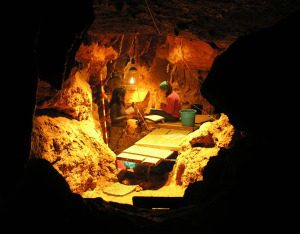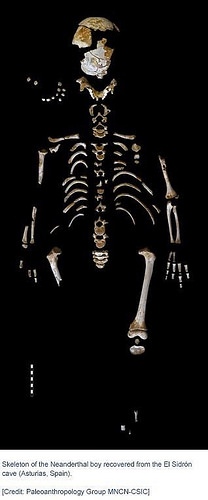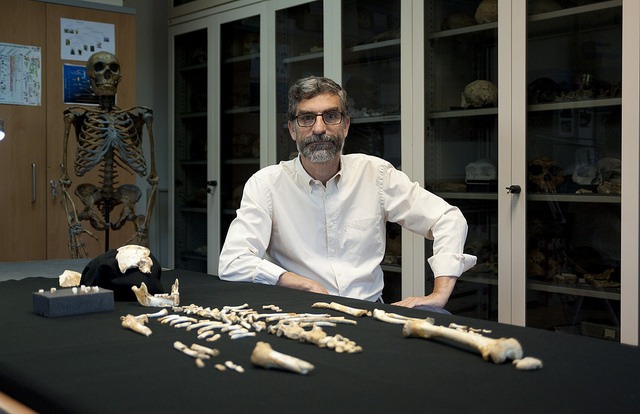
A new analysis of a well-preserved, remarkably complete Neanderthal child’s skeleton reveals that Neanderthals may have had a more extended period of brain growth compared to modern humans. An understanding of our Neanderthal cousins can provide important insights into our own biology. Of particular interest are differences in brain size, as the Neanderthal fossil record has thus far indicated that they had a larger cranial capacity than that of modern humans.
Some studies have proposed that the larger brain in Neanderthals can be explained by a faster rate of early postnatal growth, yet others have proposed a longer growth rate instead. Here, Antonio Rosas and colleagues describe a juvenile Neanderthal skeleton from the 49,000-year-old site of El Sidrón, in Spain. The specimen, dubbed El Sidrón J1, exhibits an exceptionally well-preserved mix of baby and adult teeth, providing a rare opportunity to estimate an age at death from daily dental incremental markings preserved in the teeth – leading the team to estimate that the child died at 7.69 years of age. Analysis of El Sidrón J1 also reveals that some vertebrae had still not fused in the 7-year-old Neanderthal, yet these same vertebrae tend to fuse in modern day humans around the ages of 4 to 6. Interestingly, the brain of El Sidrón J1 was roughly 87.5% of the size of an average adult Neanderthal brain upon death, whereas modern humans tend to have on average 95% of adult brain weight by that same age. The authors suggest that the unique pattern of vertebral maturation and extended brain growth might reflect the broad Neanderthal body form and physiology, rather than a fundamental difference in the overall pace of growth in Neanderthals.
It is important to note that, while Rosas and colleagues have identified these differences between the Neanderthal and the modern human, or Homo sapiens, for the most part, their growth development is very similar.
The El Sidrón Cave is a limestone karst cave system located in Asturias, northwestern Spain. Here, Paleolithic rock art and more than a dozen fossils of Neanderthals and 53 associated stone tools were found. The discovery was initially made accidentally in 1994, eventually revealing the remains of what scientists identified to be 13 individuals, including adolescent boys, a younger juvenile, women, and infants, dated to about 49,000 years ago. Analysis of the bones suggested that they may have been dropped into the cave in a single ancient event via a collapse of nearby fissures above the site, or by the influx of storm water.
The first sequencing of the Neanderthal Y chromosome was successfully achieved using a bone sample taken from the El Sidrón Cave. The results of DNA analysis indicated that Neanderthals diverged from a common ancestor with modern humans around 590,000 years ago.
Other research on the El Sidrón Neanderthals has shown that their diet consisted primarily of pine nuts, moss and mushrooms, unlike the primarily carnivorous diet of other Neanderthals.
Regarding this most recent study, Rosas and colleagues emphasize that this is really ony a first step, and future research will entail analyzing the remains of Neanderthals from the site and other sites, to increase the overall sample size under study to either qualify or further verify or validate their findings.
_________________________________
Researchers working inside the El Sidrón cave. Credit: Paleoanthropology group MNCN – CSIC
_____________________________________________
Antonio Rosas inside the El Sidrón cave. Credit: Joan Costa – CSIC Communication
_______________________________________________
Antonio Rosas beside the Neanderthal child’s skeleton. Credit: Andrés Diaz – CSIC Communication
______________________________________________
Article Source: Adapted and edited from a American Association for the Advancement of Science news release
______________________________________________
Receive 30 days free access to the popular new CuriosityStream lineup of documentaries on science, history, nature, and technology as a new Popular Archaeology premium subscriber.
___________________________________________
Travel and learn with Far Horizons.
____________________________________________









